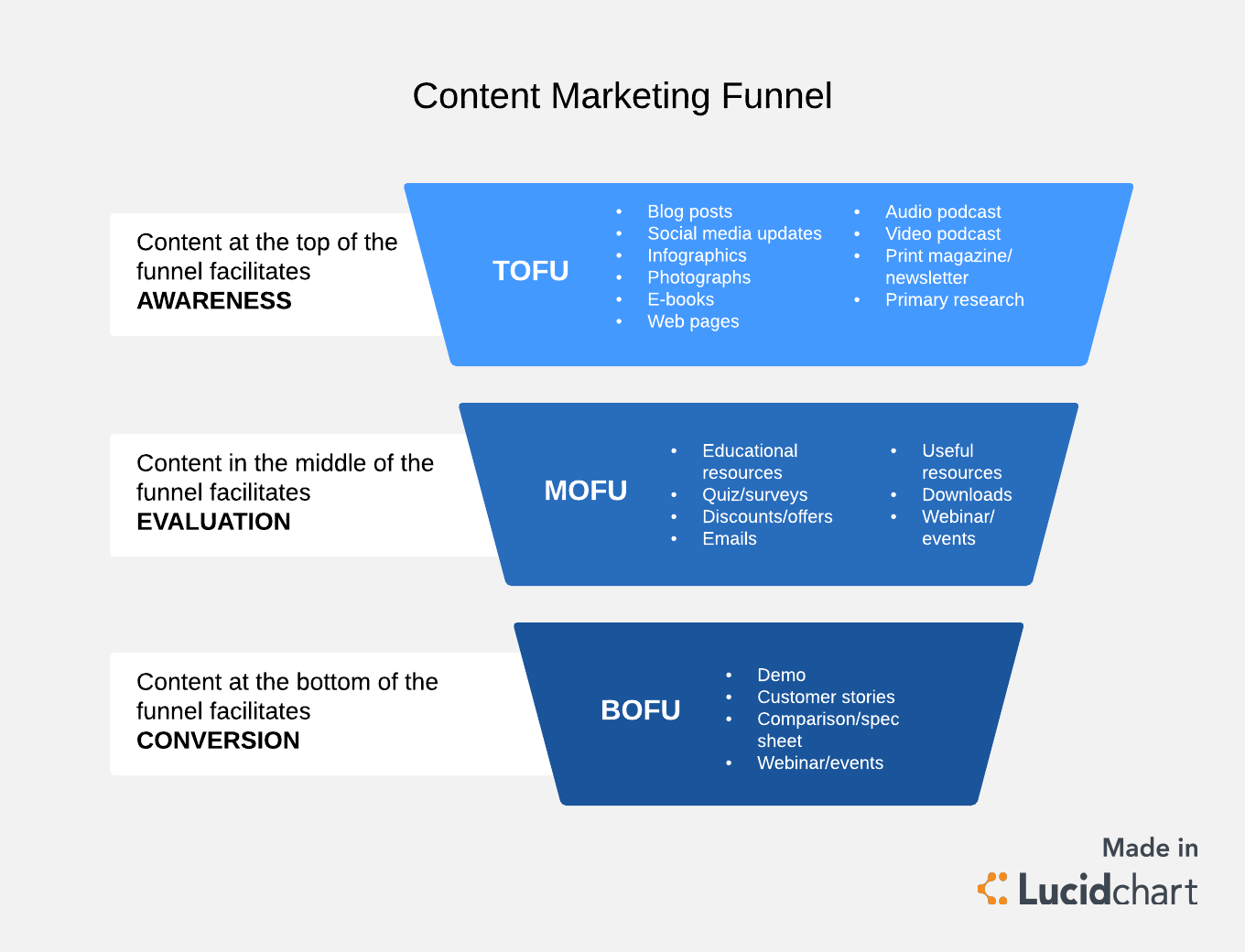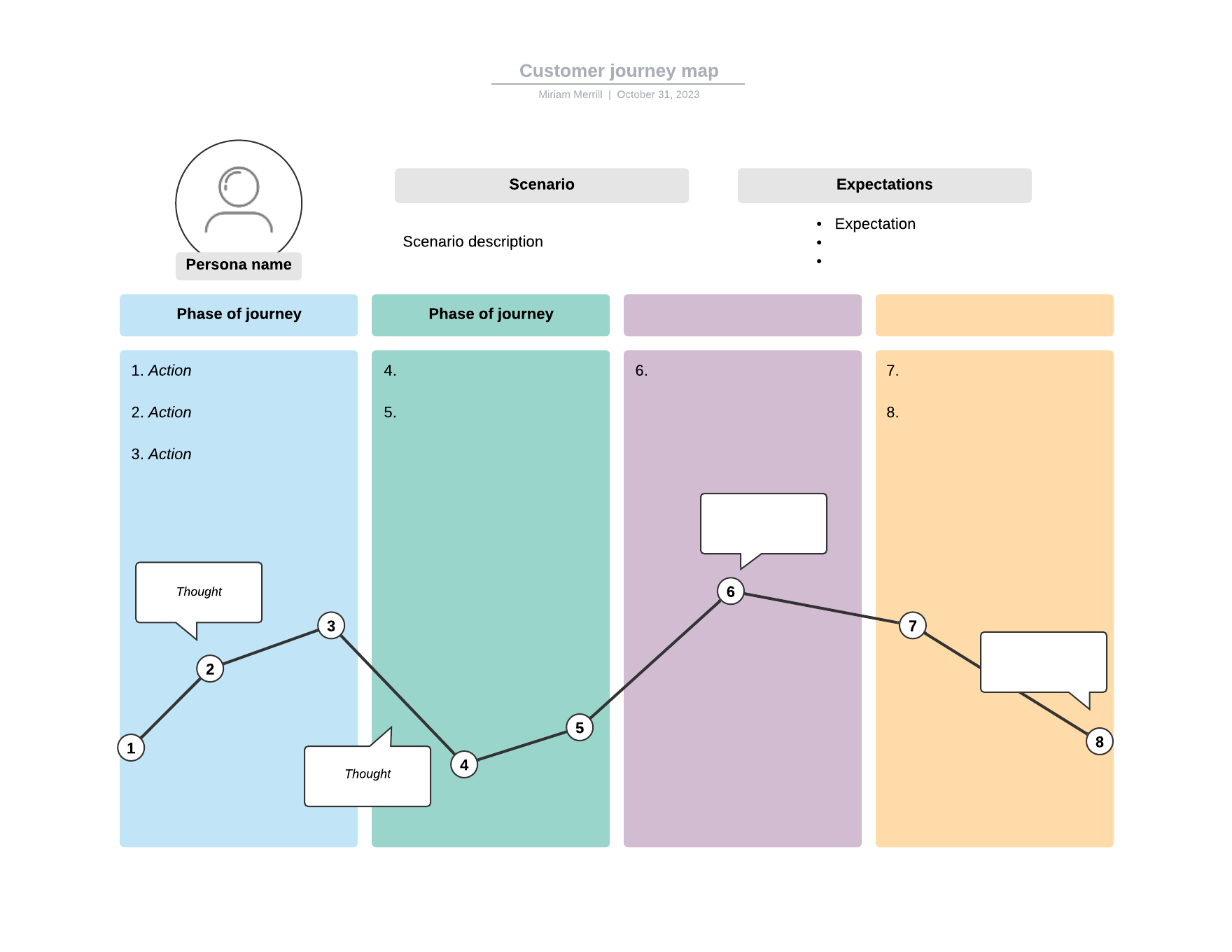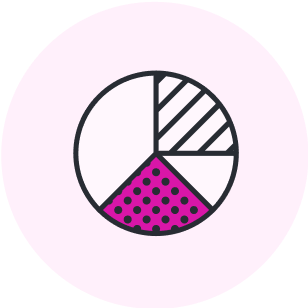Marketing funnel phases
- Awareness - Content focused on educating your audience.
- Evaluation - Customers determine whether they need your product.
- Conversion - Reasons to buy your product.
- Delight - Keeping your audience engaged.
Like it or not, a lot of the content we consume online has a very specific purpose: to get you to buy. Or sign up. Or learn more. Even the seemingly fluffy pieces like “The 10 best dog-friendly hotels in Seattle” have been crafted to influence a specific response.
Why? Because most of the content we read and interact with on a daily basis is part of the content marketing funnel. In this article, you'll learn more about this content funnel and different types of content marketing.

What is the content marketing funnel?
The content marketing funnel visualizes the journey that potential customers go through when considering a purchase, and it’s part of a larger overall content marketing strategy. The content in the different stages supports the customer journey, and good content pushes your leads closer to a purchase.
The four stages of the content marketing funnel are awareness, evaluation, purchase (or "conversion"), and delight. Each stage serves a specific purpose in the customer's journey, as should the content presented to the customer in those stages.
A comprehensive content marketing strategy addresses these questions:
- What type of content do I need to create?
- How will I measure the success of my content?
- Where can I improve my content strategy?
To understand how your content fits into the overall customer journey from discovery to purchase, you may want to build a customer journey map.

1. Awareness
When potential customers first enter into the content marketing funnel, you should assume that they are unaware of your company or the solution you provide. It’s now your job to make them aware. This stage is at the top of the funnel where your audience is just starting their journey with you and entering the content funnel.
Top-of-funnel (TOFU) content focuses on educating your audience. You can use content types such as:
- Shareable blog posts
- Social media posts
- Infographics
- Videos
- E-books
- Podcasts
But don’t stress—you don’t have to try every single content type. Test a few that seem to resonate with your intended audience and track their success. With each piece of content you create, ask yourself:
- Are prospects viewing, interacting with, and sharing the content?
- Is my target audience interacting with my content?
- Is there any follow-through after interaction?
Use metrics like time on page, number of reviews, and bounce rate to assist in answering these questions, and dig into Google Analytics to understand more. If you find that your content falls short or doesn’t address the correct audience, pivot. Just because you’ve started on one path doesn’t mean you can’t make changes to your strategy.
2. Evaluation
In the middle of the funnel (MOFU), potential customers determine whether they need your product or service. You’re also attempting to build trust with your consumer in the evaluation stage. No one buys from or does business with a company they don’t trust, so look for ways to build that relationship.
Consumers are looking for content that demonstrates why they should choose your product or service:
- Case studies
- White papers
- Emails
- Useful resources/downloads
- Events/webinars
Again, ask yourself if your content is fulfilling its intended purpose:
- Are people converting from this content?
- Am I generating new sales or leads from this content?
- Is this content helping or hurting my end goal?
Good content creation helps incrementally move a prospect toward a purchase. It doesn’t happen all at once, so don’t expect one piece to do all the heavy lifting. That’s why it’s so important to vary the types of content marketing you use and to have a comprehensive content strategy in place that moves your prospective customers through the content funnel.
3. Conversion
Everyone wants to feel confident in a purchase. Give your potential customers very clear reasons why buying your product or investing in your service is the smart thing to do.
The content funnel up to this point has been about getting customers interested in your product. Now, at the bottom of the content marketing funnel (BOFU), give them a reason to buy.
Build customer confidence and entice them to buy with content like
- Customer reviews
- Demos
- Product comparisons
- Free trials
This is your chance to really talk up your product or service. By offering side-by-side comparisons of similar products—and highlighting how your product or service is superior—you can easily influence a purchase.
Offering a free trial of your service can also lead to a purchase, as long as you aren’t giving away the whole product. An introductory trial gives potential consumers a taste of what you do but should leave them wanting more, since your objective is to convert them to a sale. For example, consider emailing prospective customers after a webinar with an offer to try the product free for a couple weeks.
Keep in mind the following:
- Does my content have a clear call to action?
- Am I making the purchase process as simple as possible?
- Is the content personalized and targeted to the right audience at the right time (or phase) in the journey?
According to a study by Salesforce, 52% of customers expect offers to always be personalized—–and 66% of customers expect companies to understand their unique needs and expectations.
A content funnel should help you deliver more personalized, seamless, and engaging interactions with your customers. So pay attention to your user data and marketing metrics to understand who your audience is, where they are in the customer journey, and when to reach out. The better targeted your content, the more likely you will convert your audience to paying customers.
4. Delight
Although it’s not part of the traditional content marketing funnel, many companies have added an additional step to retain or delight customers.
Your overall content strategy should be aimed at building an audience and keeping them engaged. That work extends beyond the purchase stage.
Your content should give customers simple ways to stay engaged and share their feedback with your business. Ask yourself:
- Does this content encourage customers to leave feedback?
- Does the content give readers reasons to refer their friends?
- Does this content showcase real customer successes?
Reward your audience with special promotions or early previews of new products. 91% of customers say they’re more likely to make another purchase after a great service experience. Even if your customer isn’t a repeat buyer, they still have influencing power in their social circles.
How to build an effective content marketing funnel
If you’re creating content, chances are it already falls somewhere in the content funnel. The key is to be deliberate and strategic about what types of content you create and how much content you create for each stage.
For instance, you might have a successful conversion rate but too few leads. So you may need to focus more on TOFU content to bring people into the content funnel. From there you can lead your customers to additional resources and MOFU and BOFU content as they engage with your brand.
Just remember to keep your content personalized and targeted at every touchpoint to create a seamless and engaging customer experience.
We also compiled a list of useful resources and tools that can help with creating or promoting the content pieces mentioned above:
- For creating shareable blog posts, try HubSpot’s blog post maker.
- To schedule social media posts ahead of time using tools like Hootsuite or CoSchedule.
- Read through our how to make an infographic guide, to help you get started on creating your infographic using flowcharts.
- For video editing, try using Apple’s default video editing software, iMovie, which is also pre-installed on mobile Apple devices. If you're not a Mac user, Windows also has a pre-installed video editing option.
- To create quick and easy E-books use Adobe’s E-book creator tool.
- For podcast audio editing, you can try either Audacity or GarageBand.
Plan for success
Creating content that converts is the top objective of the content marketing funnel. With a solid strategy in place, your business will be able to engage with and influence customers at every stage of the content marketing funnel.
But a strong content strategy is just part of the overall equation. It’s also important to understand how your content pieces are performing using defined metrics. Regularly check in on your existing pieces of content and look for ways to improve or repurpose them. And don’t forget to give new and future customers a reason to come back.
Engagement does not end with a conversion or purchase. Leverage the planning power of Lucidchart to expand and grow your content marketing funnel.

Explore templates made just for marketing teams.
Go nowAbout Lucidchart
Lucidchart, a cloud-based intelligent diagramming application, is a core component of Lucid Software's Visual Collaboration Suite. This intuitive, cloud-based solution empowers teams to collaborate in real-time to build flowcharts, mockups, UML diagrams, customer journey maps, and more. Lucidchart propels teams forward to build the future faster. Lucid is proud to serve top businesses around the world, including customers such as Google, GE, and NBC Universal, and 99% of the Fortune 500. Lucid partners with industry leaders, including Google, Atlassian, and Microsoft. Since its founding, Lucid has received numerous awards for its products, business, and workplace culture. For more information, visit lucidchart.com.
Related articles
How to map accounts for account-based marketing
Follow these six steps to mapping accounts to optimize your account-based marketing efforts.
Making customers for keeps: How to win with retention marketing
Keeping a customer coming back for more—increasing their lifetime value and even turning them into a brand advocate—requires a thoughtful, strategic retention marketing plan. Learn what retention marketing is and how to develop a retention marketing program.
4 ways to improve communication between marketing and sales
Close deals faster—together. Learn four different strategies that marketing and sales teams can use to improve workplace communications, uncover bigger opportunities, and increase overall revenue by working together.
How to refine your marketing funnel and earn devoted customers
Marketing teams can use the marketing funnel to see how customers find their company and why they choose it. See how to make one in Lucidchart!

